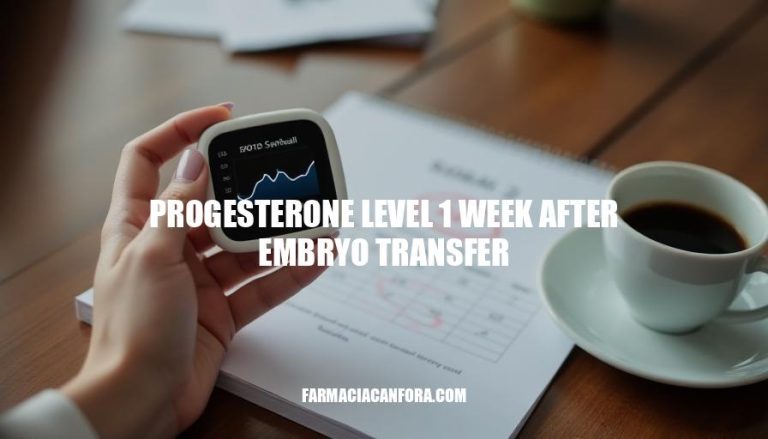


Progesterone levels one week after embryo transfer are really important in fertility treatments. This hormone gets the uterus ready for a fertilized egg to attach and helps support early pregnancy. Checking progesterone levels helps doctors figure out if implantation is happening and if the pregnancy will continue, which is why it’s such an important part of these treatments.
Progesterone levels one week after embryo transfer can be influenced by several key factors, including hormone supplementation, individual variability, and embryo quality.
Hormone Supplementation: The type, dosage, and route of progesterone supplementation play a crucial role in determining progesterone levels. Progesterone can be administered orally, vaginally, or through injections. The timing of administration and the specific regimen used can significantly impact serum progesterone levels.
For instance, higher doses or more frequent administration can lead to elevated progesterone levels, while lower doses or less frequent administration may result in lower levels.
Individual Variability: Each individual’s body responds differently to hormone supplementation due to factors such as age, body mass index (BMI), metabolic rate, and overall health. Genetic factors can also influence how the body metabolizes and utilizes progesterone, leading to variations in serum levels among different individuals.
Embryo Quality: The quality of the embryo transferred can affect the hormonal environment required for successful implantation and pregnancy. High-quality embryos may require a more optimal hormonal milieu, including appropriate progesterone levels, to support implantation and early pregnancy.
Conversely, lower-quality embryos might not be as dependent on precise hormonal conditions, potentially leading to variations in progesterone levels required for successful outcomes.
These factors collectively contribute to the complexity of managing progesterone levels after embryo transfer and highlight the importance of personalized approaches in assisted reproductive technology (ART) protocols.
Monitoring progesterone levels one week after embryo transfer is crucial for assessing the viability of the pregnancy and guiding potential interventions. The primary method for monitoring progesterone levels is through blood tests. These tests measure serum progesterone levels to ensure they are within the optimal range for supporting a healthy pregnancy.
Interpreting the results involves comparing the measured progesterone levels to established thresholds.
Typically, progesterone levels should be between 10-20 ng/mL one week after embryo transfer. Levels below this range may indicate luteal phase insufficiency, which can lead to implantation failure or early pregnancy loss. Conversely, excessively high levels may also negatively impact pregnancy outcomes.
Implications for pregnancy outcomes are significant.
Adequate progesterone levels are essential for maintaining the endometrial lining and supporting early pregnancy. Low progesterone levels can result in miscarriage or failed implantation, while optimal levels increase the chances of a successful pregnancy.
Timely monitoring is vital because it allows for early detection of any issues that may arise. Prompt interventions, such as adjusting progesterone supplementation, can be implemented to improve pregnancy outcomes.
Possible interventions include increasing the dosage of progesterone supplements or changing the route of administration (e.g., from oral to intramuscular).
These adjustments help maintain the necessary hormonal support for the developing pregnancy.
In summary, monitoring progesterone levels one week after embryo transfer is a critical component of assisted reproductive technology. It provides valuable information for guiding interventions and improving the chances of a successful pregnancy.
Monitoring progesterone levels one week after embryo transfer is crucial in fertility treatments as it helps assess the viability of the pregnancy and guides potential interventions.
Progesterone plays a vital role in preparing the uterus for a fertilized egg to attach and supporting early pregnancy.
Several factors can influence progesterone levels, including hormone supplementation, individual variability, and embryo quality.
Hormone supplementation type, dosage, and route can significantly impact serum progesterone levels, while individual factors such as age, BMI, metabolic rate, and overall health can also affect how the body responds to hormone supplementation.
Embryo quality can also impact the hormonal environment required for successful implantation and pregnancy, with high-quality embryos potentially requiring a more optimal hormonal milieu.
Monitoring progesterone levels through blood tests is essential, with typically recommended levels between 10-20 ng/mL one week after embryo transfer.
Adequate progesterone levels are critical for maintaining the endometrial lining and supporting early pregnancy. Low progesterone levels can result in miscarriage or failed implantation, while optimal levels increase the chances of a successful pregnancy.
Timely monitoring allows for early detection of any issues that may arise, enabling prompt interventions such as adjusting progesterone supplementation to improve pregnancy outcomes.
Maintaining optimal progesterone levels is essential for successful embryo implantation and early pregnancy, highlighting the importance of medical guidance and personalized care in assisted reproductive technology (ART) protocols.